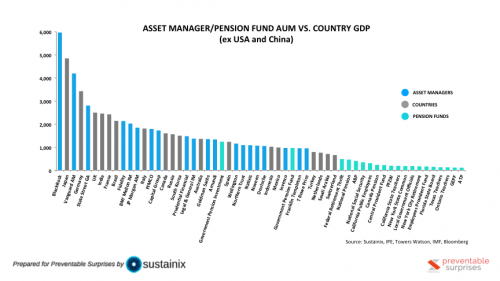Goliath Asset Management vs. David Pension Fund
If you had to quickly pick which is the most powerful–sovereign countries, asset owners, or the investment firms both hire to manage their assets–who would get your vote? If money is power–measured either by AUM or GDP–the chart below offers an interesting perspective. Excluding the two largest economies (the U.S. and China), the chart shows:
- Among the 15 largest entities, eight are investment firms and seven are countries.
- Among the next-largest 15, ten are investment firms and five are countries.
- The smallest 16 players are some of the world’s largest pension funds.

A forthcoming report from Preventable Surprises will show that the two largest asset managers shown here voted against every 2°C scenario resolution put forward by shareholders at U.S. utilities. Most of the pension funds shown–which are duty bound to serve the long-term interests of their future beneficiaries–worked hard to support these same resolutions.
Something is wrong with this picture. How can the desires of long-term investors for a 2°C-aligned economy be ignored by the investment firms voting proxies on their behalf?
Strength in numbers
Individual asset owners–large though they may be–have not been effective in influencing the firms hired to manage their funds. Asset owners must work together to magnify their voices and make it impossible for investment firms to ignore their wishes. As the Red Line Voting project is showing only greater collaboration between asset owners will shift the dial.
A coordinated effort would begin with private discussions with outside managers clarifying expectations. Ultimately, though, laggard fund managers need to be sacked and RFPs need to reflect a nonnegotiable demand for forceful stewardship.